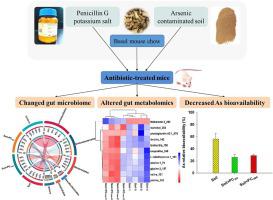Environment International ( IF 11.8 ) Pub Date : 2021-02-20 , DOI: 10.1016/j.envint.2021.106444 Meng-Ya Li 1 , Xiao-Qiang Chen 1 , Jue-Yang Wang 1 , Hong-Tao Wang 2 , Xi-Mei Xue 3 , Jing Ding 4 , Albert L Juhasz 5 , Yong-Guan Zhu 3 , Hong-Bo Li 1 , Lena Q Ma 6

|
Oral bioavailability of arsenic (As) determines levels of As exposure via ingestion of As-contaminated soil, however, the role of gut microbiota in As bioavailability has not evaluated in vivo although some in vitro studies have investigated this. Here, we made a comparison in As relative bioavailability (RBA) estimates for a contaminated soil (3913 mg As kg−1) using a mouse model with and without penicillin perturbing gut microbiota and metabolites. Compared to soil exposure alone (2% w/w soil in diets), addition of penicillin (100 or 1000 mg kg−1) reduced probiotic Lactobacillus and sulfate-reducing bacteria Desulfovibrio, enriched penicillin-resistant Enterobacter and Bacteroides, and decreased amino acid concentrations in ileum. With perturbed gut microbiota and metabolic profile, penicillin and soil co-exposed mice accumulated 2.81–3.81-fold less As in kidneys, excreted 1.02–1.35-fold less As in urine, and showed lower As-RBA (25.7–29.0%) compared to mice receiving diets amended with soil alone (56 ± 9.63%). One mechanism accounted for this is the decreased concentrations of amino acids arising from the gut microbiota shift which resulted in elevated iron (Fe) and As co-precipitation, leading to reduced As solubilization in the intestine. Another mechanism was conversion of bioavailable inorganic As to less bioavailable monomethylarsonic acid (MMAV) and dimethylarsinic acid (DMAV) by the antibiotic perturbed microflora. Based on in vivo mouse model, we demonstrated the important role of gut microbiota and gut metabolites in participating soil As solubilization and speciation transformation then affecting As oral bioavailability. Results are useful to better understand the role of gut bacteria in affecting As metabolism and the health risks of As-contaminated soils.
中文翻译:

抗生素暴露通过破坏回肠微生物群和代谢特征降低小鼠土壤砷口服生物利用度
砷 (As) 的口服生物利用度决定了通过摄入受 As 污染的土壤暴露的 As 水平,然而,尽管一些体外研究对此进行了研究,但尚未在体内评估肠道微生物群在 As 生物利用度中的作用。在这里,我们使用小鼠模型对受污染土壤 (3913 mg As kg -1 )的 As 相对生物利用度 (RBA) 估计值进行了比较,该模型使用和不使用青霉素扰动肠道微生物群和代谢物的小鼠模型。与单独的土壤暴露(饮食中 2% w/w 土壤)相比,添加青霉素(100 或 1000 mg kg -1)可减少益生菌乳酸杆菌和硫酸盐还原菌脱硫弧菌,富集耐青霉素肠杆菌和拟杆菌属,并降低回肠中的氨基酸浓度。由于肠道微生物群和代谢特征受到干扰,青霉素和土壤共同暴露的小鼠在肾脏中积累的 As 减少了 2.81-3.81 倍,尿液中的 As 排泄量减少了 1.02-1.35 倍,并且显示出较低的 As-RBA (25.7-29.0%)接受仅用土壤改良的饮食的小鼠 (56 ± 9.63%)。造成这种情况的一种机制是肠道微生物群变化引起的氨基酸浓度降低,导致铁 (Fe) 和 As 共沉淀升高,从而导致肠道中的 As 溶解度降低。另一种机制是将生物可利用的无机砷转化为生物可利用性较低的单甲基胂酸 (MMA V ) 和二甲基胂酸 (DMA V) 受到抗生素干扰的微生物群落。基于体内小鼠模型,我们证明了肠道微生物群和肠道代谢物在参与土壤 As 溶解和物种形成转化中的重要作用,进而影响 As 口服生物利用度。结果有助于更好地了解肠道细菌在影响砷代谢和砷污染土壤的健康风险中的作用。

























 京公网安备 11010802027423号
京公网安备 11010802027423号